Another Spring Tour today. After a cool start, it was mostly a lovely sunny day with light winds. The plan was to visit Titchwell and Holkham, but we decided to head towards Choseley first, cross-country via a few inland country roads.
The first birds we came upon were a pair of Stone Curlew in a field beside the road. A real conservation success story, this species has spread north in recent years from its traditional stronghold in the Brecks. A great way to start the day. A Grey Partridge was trying to hide in the grass nearby. A little further along, we found a Turtle Dove perched up in the top of a hawthorn. Unfortunately, just as we got the scope onto it, it flew off. There were also lots of Skylarks singing, Linnets flying round calling and a Whitethroat giving its scratchy song from the wires above us.
Stopping to scan the sky from a suitable high vantage point, we had hoped to add a Buzzard or a Red Kite to the day’s list. However, the biggest surprise of the day was a ringtail Montagu’s Harrier which circled up in the distance, not a bird we had expected to see here today. We got it in the scope and could just make out the white uppertail coverts before it flew off strongly.
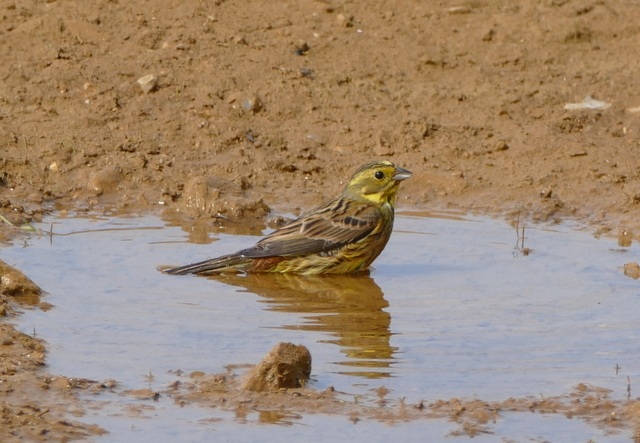 Yellowhammer – taking a bath in a puddle right beside us
Yellowhammer – taking a bath in a puddle right beside us
There were smart male Yellowhammers with glowing yellow heads everywhere as we drove towards Choseley – in the road, on the wires. We also came across a Corn Bunting in the hedge beside the road. As we rolled the car back to get a better look at it, it flew round ahead of us and was joined by a second. We could just see the two of them feeding in the bushes. Up on the top of the ridge, as we got out of the car, another Corn Bunting was singing, like a bunch of jangling keys. A male Yellowhammer was singing behind us as well. As we walked out along the track, a female Yellowhammer dropped down to a puddle in front of us to bathe.
 Chaffinch – this smart male was catching flies in the verge
Chaffinch – this smart male was catching flies in the verge
By this stage, the sun had come out and it was starting to get rather warm. There was increasing heat haze across the field where the Dotterel have been in recent weeks. Two had been reported earlier in the morning, but we couldn’t find them today. They have the ability to blend in amongst the stones once they sit down anyway, but with the growth of the sugar beet and rogue potato plants in the field, they have got harder and harder to pick up unless they are running around. Rather than waste too much time looking for them this morning, we decided to head down to Titchwell.
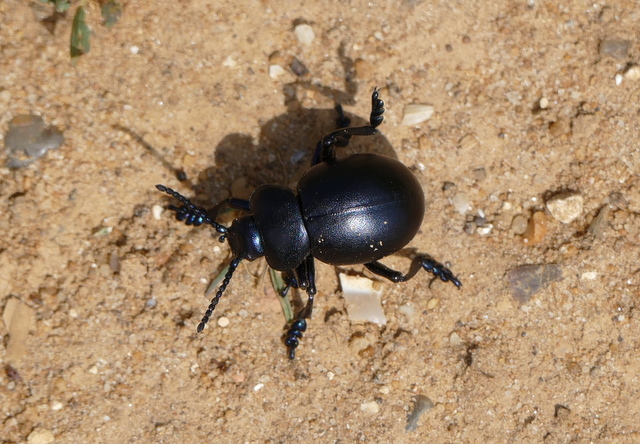 Bloody-nosed Beetle – also by the path at Choseley today
Bloody-nosed Beetle – also by the path at Choseley today
A Blackcap was singing in the car park as we arrived at Titchwell. As we walked out onto the reserve, we could hear several Reed Warblers singing either side of the path. The Sedge Warblers have gone a little quieter now than they were when they first arrived, but one perched up in the brambles where we could get it in the scope and gave a burst of song to allow us to compare it to its plainer cousins. The Cetti’s Warblers are also less vocal now than they were – now that they are too busy breeding. One Cetti’s Warbler kept flying out of a particular patch of brambles into the reeds, then returning a few seconds later, presumably taking food back to its nest. We only really saw it in flight, but we could see its distinctive reddish chestnut upperparts.
There were several dragonflies and damselflies by the path today – their numbers have really increased as the weather has warmed up recently. We saw Hairy Dragonfly and Four-spotted Chaser amongst the former and Large Red Damselfly and Blue-tailed Damselfly amongst the latter.
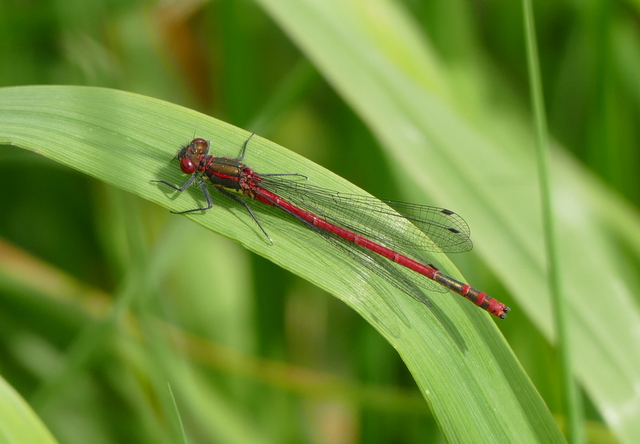 Large Red Damselfly – by the main path at Titchwell
Large Red Damselfly – by the main path at Titchwell
One of the channels through the reeds held a female Red-crested Pochard, which we got in the scope. Then a male dropped into the reedbed pool a little further along and we had a good look at him too. There were also Common Pochards to compare, and a couple of Tufted Ducks, out on the pool today.
We could hear a Cuckoo singing distantly at first. Then it gradually made its way closer before flying out over the Thornham saltmarsh. We saw it do a circuit and head back to the trees by the visitor centre, before returning right past us and landing briefly in the sallows by Island Hide. It didn’t stop there long, but flew out across the reedbed rather like a cross between a hawk and a falcon and landed in the top of a bush, where we could get a proper look at it.
We could hear several Bearded Tits ‘pinging’ out in the reedbed as well. However, in typical fashion all we saw was them darting about over the tops of the reeds before dropping into cover. A pair perched briefly once, but too briefly to get everyone onto them. The Reed Buntings were more accommodating.
 Little Gull – 1 of at least 6 birds on the freshmarsh today, all 1st summers
Little Gull – 1 of at least 6 birds on the freshmarsh today, all 1st summers
There was lots of activity out on the freshmarsh from Island Hide as usual. As soon as we arrived, we could see a young (1st summer) Little Gull swimming close to the hide, twirling round and picking insects off the surface of the water. A closer look revealed at least six Little Gulls, all 1st summer birds, out on the freshmarsh. It was hard to judge just how small they were out on their own, but their small size became apparent as soon as they came close to any other birds.
We had already seen a couple of Common Terns patrolling over the reedbed pool on our way out. Two Little Terns were on one of the islands from the hide, and we got them in the scope and admired their black-tipped yellow bills and white foreheads. A single Sandwich Tern flew in and around the freshmarsh briefly, before heading off towards Brancaster. A good selection of terns.
There were lots of noisy Avocets in front of the hide, as usual. At one point, two pairs decided to have a bit of an argument. They started by facing off against each other, in pairs, dipping their bills into the water. Then one would dive across at the other pair, flapping its wings. Eventually they lost interest, and the two pairs walked off in opposite directions.
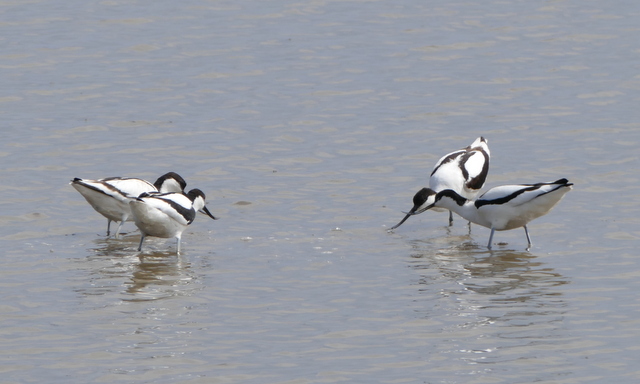
 Avocets – two pairs having a turf war in front of Island Hide today
Avocets – two pairs having a turf war in front of Island Hide today
There were still a few ducks out on the freshmarsh. Several pairs of the under-rated and very subtle Gadwall and quite a few big-billed Shoveler. The Shelduck in particular are looking very good at the moment. However, much of the wildfowl which was here over the winter has now departed. We only saw three Brent Geese today, out over the saltmarsh towards Thornham Harbour.
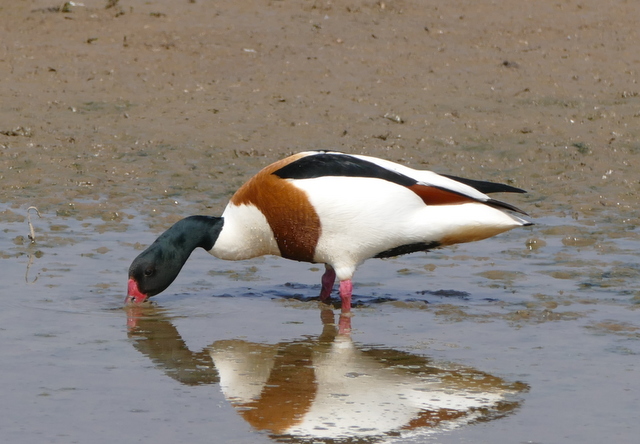 Shelduck – a very good-looking Sheldrake
Shelduck – a very good-looking Sheldrake
Wader numbers have also tailed off and wader migration has been a little disappointing in recent days. There was the usual group of Black-tailed Godwits roosting on the biggest island at the back, with three birds more helpfully feeding in the water a little closer. Aside from that, and other than a few Redshank, the only waders of note today were a couple of Little Ringed Plovers. At least we got a good look at them from Parrinder Hide, and we could see their golden-yellow eye-rings from up close.
 Little Ringed Plover – two were on the mud in front of Parrinder Hide today
Little Ringed Plover – two were on the mud in front of Parrinder Hide today
The Volunteer Marsh and Tidal Pools were both quiet again today. Out on the beach, the tide was quite well in. The only waders were a little group of summer-plumaged Sanderling which flew past along the shoreline. Several Sandwich Terns were feeding offshore. And there was a single drake Common Scoter on the sea.
We walked back for a late lunch, stopping briefly to look again at the reedbed pool. We had hoped to pick up the Great Crested Grebe which is often on here for the day’s list, and it duly obliged. However, the bonus came in the shape of a pair of Garganey which swam out into the middle from the reeds. The female proceeded to bathe, while the male stood guard nearby, flashing his white headstripe in the sunshine.
After lunch, we drove back along the coast road to Holkham. Lady Anne’s Drive was very busy, but we found a parking space and as soon as we turned west before the pines we left behind the crowds which were almost all heading straight out onto the beach.
It was a little quiet in the trees in the heat of the early afternoon. A couple of Chiffchaff sang from the tops of the bushes and an interesting Willow Warbler, a ‘mixed singer’, started off with a convincing short burst of Chiffchaff-like song before relapsing to more appropriate Willow Warbler repertoire. A pair of Coal Tits fed on the edge of a Holm Oak and a couple of groups of Long-tailed Tits called from the pines. We could also hear Goldcrests singing and Treecreepers calling, but neither gave themselves up today.
The view from Joe Jordan hide initially seemed quite tranquil. The usual pair of Grey Partridge fed quietly in the grass below the hide. A few Grey Herons and Little Egrets flew back and forth, and a steady passage of Cormorants came and went from the trees. There were quite a few Marsh Harriers flying around and a nice male in particular made a low pass across the grass in front of us.
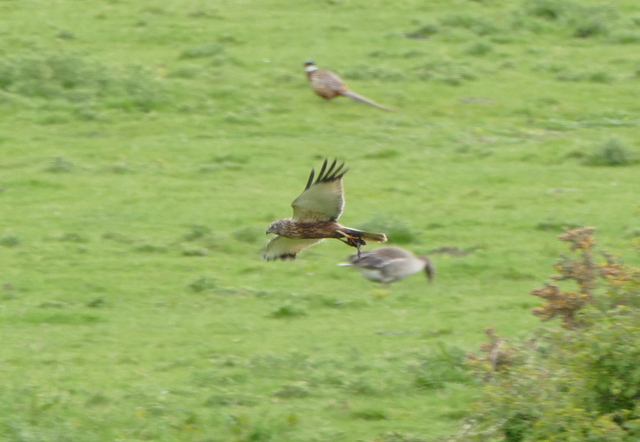 Marsh Harrier – flew low past us in front of Joe Jordan hide
Marsh Harrier – flew low past us in front of Joe Jordan hide
On first inspection, the ‘nursery pool’ below the heronry looked fairly empty. However, after we had been siting in the hide for a short while, we realised there were actually several large white shapes concealed in the rushes on the front edge. They were asleep at first, but once they woke up, we could see that they were actually juvenile Spoonbills – or Teaspoonbills, given their half grown bills. The first birds have obviously fledged in the last couple of days and were now creched on the edge of the pool.
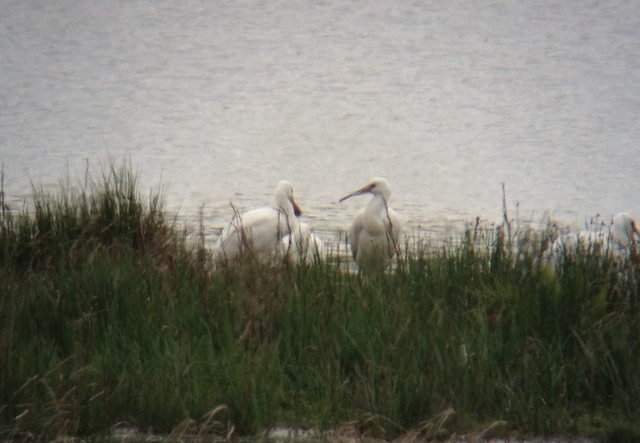 Spoonbills – freshly fledged juveniles with partly grown teaspoon-bills
Spoonbills – freshly fledged juveniles with partly grown teaspoon-bills
As we sat and watched them, a steady stream of adult Spoonbills flew down from the trees to bathe and preen on the edge of the pool. At one stage, we could see at least 8 adults and 4 juveniles standing around. It was great to see the adults and juveniles together. As well as having diminutive bills, the young Spoonbills were clearly smaller and whiter than the grown-ups.
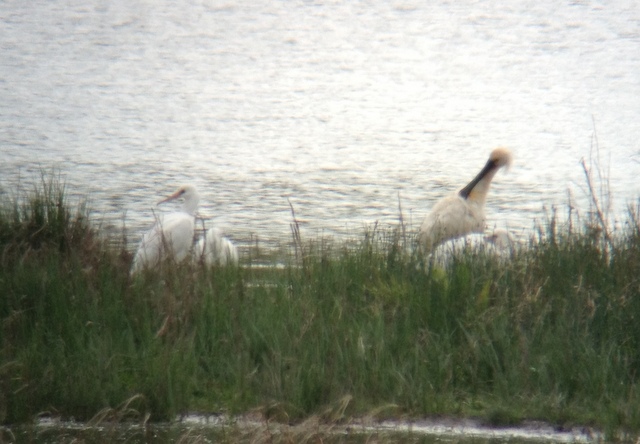 Spoonbills – large-billed adult preening with small-billed juveniles nearby
Spoonbills – large-billed adult preening with small-billed juveniles nearby
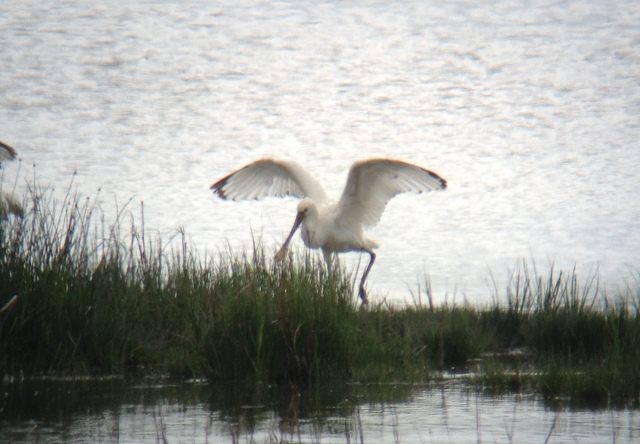 Spoonbill – probably a 1st summer, with full-sized bill and black wing tips
Spoonbill – probably a 1st summer, with full-sized bill and black wing tips
We spent some time watching the comings and goings of the Spoonbill families, and all the other birds. A Red Kite circled up over the trees. A pair of Mediterranean Gulls flew over calling. There was non-stop action from the Joe Jordan hide this afternoon and in the end we had to tear ourselves away and head for home.
















